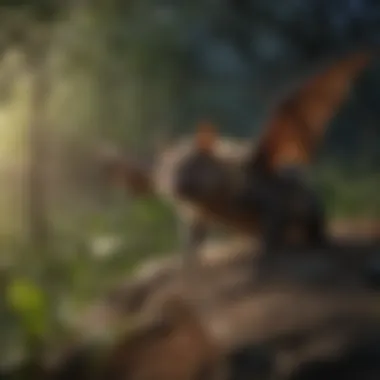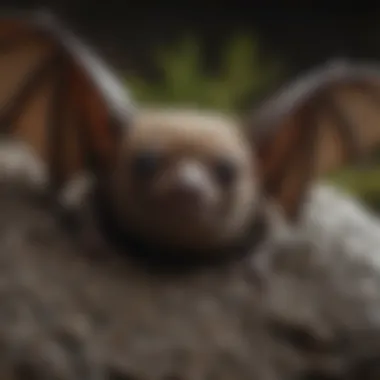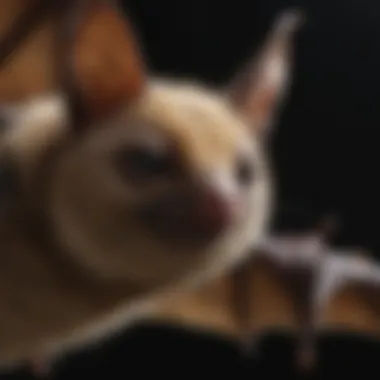Unveiling the Diverse Universe of Bats: An In-Depth Exploration of Different Bat Species


Overview of the Topic
Bats, often misunderstood creatures of the night, play a crucial role in various ecosystems worldwide. Their diversity spans a wide range of species, each with unique physical attributes and behavior patterns. Understanding the intricacies of different kinds of bats is essential to grasp their importance in maintaining ecological balance.
Current Status and Challenges
Currently, bats face numerous challenges that threaten their populations. Habitat loss due to deforestation and urbanization poses a significant risk to their survival. Additionally, climate change impacts insect populations, affecting the food sources of many bat species. Human disturbances, like light pollution and disease transmission, further contribute to the decline in bat numbers.
Sustainable Solutions
To combat the challenges facing bat populations, implementing sustainable practices is imperative. Conservation efforts focusing on preserving natural habitats, creating artificial roosting sites, and reducing human disturbances can aid in safeguarding bat populations. Educational programs highlighting the significance of bats in ecosystems can also promote coexistence and support conservation initiatives.
Impact and Importance
The impact of bats extends far beyond their nocturnal activities. As essential pollinators and pest controllers, bats contribute significantly to agricultural health and biodiversity. Their decline could lead to imbalances in ecosystems, affecting crop yields and increasing the prevalence of insect-borne diseases. Recognizing the importance of bats in ecosystem health underscores the critical need for conservation measures to secure their future and maintain ecological integrity.
Introduction
Welcome to the intriguing realm of bat diversity, where we unravel the mysteries surrounding these fascinating nocturnal creatures. As we embark on this journey through the expansive world of bats, we are presented with a golden opportunity to gain profound insight into their significance within the ecosystem. By delving into the intricate tapestry of different bat species, we are poised to uncover a wealth of knowledge that transcends mere observation, offering us a deeper understanding of the interwoven relationships that define our natural world.
In this article, we will navigate through the enchanting universe of bats, illuminating the various facets of their existence that often elude casual observers. From exploring their unique physical attributes to deciphering their behavioral patterns and ecological roles, we aim to provide a holistic perspective that celebrates the diversity and complexity of bat populations. By shedding light on the importance of studying different bat species, we will underscore the pivotal role these remarkable creatures play in maintaining the equilibrium of the environment.
As we unravel the intricate nuances of bat diversity, we strive to cultivate an appreciation for these enigmatic beings and the pivotal role they play in sustaining the delicate balance of nature. Join us as we embark on a captivating odyssey through the captivating world of bats, where every flap of their wings echoes with resilience and beauty.


Understanding Bats: An Overview
As we delve into the intricate world of bats, it becomes evident that understanding these creatures is crucial for comprehending the dynamics of our ecosystems. Bats play a pivotal role in maintaining ecological balance, primarily through their feeding habits and pollination activities. By preying on insects at night, bats help regulate insect populations, preventing agricultural pests from causing extensive damage to crops. Furthermore, many plant species rely on bats for pollination, shaping the diversity of plant life in various ecosystems. Studying bats offers a unique perspective on the interconnectedness of species and the delicate balance that sustains our natural world.
The Role of Bats in Ecosystems
The ecological significance of bats cannot be overstated. Bats are primary nocturnal predators of insects, consuming vast quantities of pests that can threaten agricultural productivity. This insectivorous behavior not only benefits farmers by reducing the need for chemical pesticides but also contributes to the health of ecosystems by controlling insect populations. Moreover, certain bat species are essential pollinators for a wide range of plants, including many economically important crops like mangoes, bananas, and agave. Through their foraging and pollination activities, bats play a vital role in maintaining biodiversity and ecosystem stability.
Importance of Studying Different Bat Species
Studying the diverse array of bat species is key to unlocking a wealth of knowledge about these enigmatic creatures. Each species exhibits unique adaptations, behaviors, and ecological roles that contribute to the overall diversity of bats. By investigating different bat species, researchers can uncover valuable insights into evolutionary processes, habitat requirements, and conservation strategies. Understanding the specific needs and characteristics of various bat species is essential for implementing targeted conservation efforts and safeguarding the rich biodiversity of bats worldwide. Through in-depth study and analysis, researchers can gain a deeper appreciation for the intricate web of life in which bats play a vital part.
Physical Characteristics of Bats
In this section, we delve into the significance of understanding the physical characteristics of bats in our exploration of bat diversity. The physical attributes of bats play a crucial role in their survival and ecological niche. A deep analysis of their wingspan, flight adaptations, echolocation, and teeth provides valuable insights into their evolutionary adaptations and biological functions.
Wingspan and Flight Adaptations
Bats exhibit a remarkable diversity in wingspan and flight adaptations, crucial for their nocturnal lifestyle and foraging behaviors. The wingspan of bats varies significantly among different species, ranging from a few inches to over five feet in megabats. This adaptation allows bats to maneuver efficiently through various habitats, from dense forests to open fields. Their unique wing structure, elongated fingers, and thin membrane enable agile flight, precise aerial acrobatics, and swift changes in direction. Studying wingspan and flight adaptations provides vital information on the evolutionary success of bats as aerial predators and pollinators.
Unique Features: Echolocation and Teeth
Echolocation and specialized dental adaptations are key features that set bats apart from other mammals. Echolocation, a sophisticated biological sonar system, enables bats to navigate, communicate, and hunt in complete darkness. By emitting high-frequency sounds and interpreting the echoes that bounce back, bats can create detailed mental maps of their surroundings with remarkable precision. Additionally, the teeth of bats are uniquely adapted for their dietary preferences, with variations in shape and size reflecting their specific feeding strategies. From insectivorous bats with sharp, pointed teeth for grasping small prey to frugivorous bats with broader molars for crushing fruits, each species showcases remarkable dental adaptations tailored to their ecological role.


Habitats of Different Bat Species
In this article, the exploration of habitats of various bat species carries substantial significance in elucidating the intricate dynamics of these nocturnal creatures. Understanding the diverse habitats where different bat species reside offers crucial insights into their ecological roles and behavioral adaptations. Habitats play a pivotal role in influencing foraging patterns, roosting preferences, and social structures of bats. By examining the habitats of various bat species, we can unravel the interconnectedness between bats and their surrounding environments, highlighting the delicate balance required for their survival. The habitats of different bat species provide a window into the complex web of interactions within ecosystems, showcasing the importance of protecting these diverse environments to ensure the conservation of bat populations.
Caves and Roosting Preferences
The preference of bats for caves as roosting sites underscores the critical link between these creatures and their shelter requirements. Bats exhibit diverse roosting behaviors depending on species, with some favoring caves due to their ideal microclimates and protection from predators. Caves offer a secure haven for bats to shelter during daylight hours, aiding in thermoregulation and energy conservation. Understanding the specific roosting preferences of different bat species within caves sheds light on their unique adaptations to varying environmental conditions. It also emphasizes the importance of conserving cave ecosystems to safeguard the habitats essential for the survival and reproduction of diverse bat populations.
Urban Environments and Human Interaction
The interaction between bats and urban environments poses both challenges and opportunities for coexistence. As urbanization continues to encroach upon natural habitats, bats have increasingly adapted to urban settings, utilizing buildings and structures as alternative roosting sites. Human development has led to modifications in landscapes that influence the distribution and behavior of bats in urban areas. Understanding the impact of human activities on bat populations is crucial for mitigating potential conflicts and promoting harmonious interactions. By exploring how bats navigate urban environments, we can implement conservation strategies that aim to minimize disturbances and enhance the conservation of diverse bat species in human-altered landscapes.
Behavioral Patterns and Social Structures
In the realm of exploring the diversity of bats, understanding their behavioral patterns and social structures holds paramount significance. Delving into these aspects not only provides a glimpse into the intricacies of bat life but also sheds light on their pivotal role within ecosystems. Behavioral patterns elucidate how bats navigate their surroundings, engage in social interactions, and survive in various habitats. By unraveling the complexities of bat behavior, researchers and conservationists can glean insights into their foraging techniques, mating rituals, and social hierarchies. The study of social structures offers valuable information on how bats communicate, cooperate, and coexist within colonies. Furthermore, examining the dynamics of bat societies helps in elucidating their evolutionary adaptations and ecological relationships.
Foraging Techniques and Diet Variations
When examining foraging techniques and diet variations among bats, a fascinating world of dietary diversity unfolds. Bats exhibit a wide array of foraging strategies, ranging from insectivorous diets to nectar-feeding habits. Their foraging techniques showcase remarkable adaptations, such as echolocation for detecting prey in darkness and agile flight maneuvers for effective hunting. Understanding the dietary preferences and foraging behavior of different bat species is crucial for comprehending their ecological roles and conservation requirements. By studying diet variations, researchers can analyze nutritional needs, energy expenditure, and feeding preferences that shape bat populations' dynamics and distribution.
Maternity Colonies and Mating Rituals
Exploring maternity colonies and mating rituals unveils the intricacies of bat reproductive behavior and group dynamics. Maternity colonies serve as hubs for nurturing offspring, fostering social bonds, and ensuring reproductive success. Understanding the structures and functions of maternity colonies provides insights into maternal care, pup development, and social interactions within bat communities. Mating rituals showcase the elaborate courtship behaviors, communication signals, and mate selection criteria employed by different bat species. By delving into these aspects, researchers can unravel the evolutionary strategies, genetic diversity, and population dynamics influenced by mating rituals and colony dynamics.


Classification of Bats Based on Taxonomy
Exploring the diversity of bats involves a detailed classification based on taxonomy. Understanding how bats are categorized provides insights into their evolutionary relationships and ecological roles. By grouping bats into distinct taxonomic categories, researchers can identify common characteristics and differences among species. This classification is vital for studying the diversity of bat species and their significant contributions to ecosystems. It enables conservationists to develop targeted conservation strategies and helps students comprehend the complexity of bat biology and behavior.
Megabats vs. Microbats: Key Differences
Differentiating between megabats and microbats is crucial in understanding the variety of bat species. Megabats, also known as fruit bats, are typically larger in size with a diet consisting mainly of fruits and nectar. On the other hand, microbats are smaller insect-eating bats that use echolocation for hunting. Understanding these key distinctions helps in appreciating the ecological niches occupied by each group and their varying impacts on the ecosystem.
Major Families of Bats: Diversity in Species
- Pteropodidae (Fruit Bats): Delving into the world of Pteropodidae reveals a group of bats primarily focused on fruit consumption. Their role in pollination and seed dispersal contributes significantly to ecosystem dynamics. The unique feature of Pteropodidae lies in their long tongues designed for extracting nectar from flowers, making them vital pollinators. However, their large size also makes them susceptible to habitat loss and hunting pressures.
- Vespertilionidae (Vesper Bats): The Vespertilionidae family encompasses a wide range of bats adapted to various habitats worldwide. Their ability to thrive in diverse environments showcases their adaptability and resilience. One key characteristic of Vespertilionidae is their echolocation prowess, allowing them to navigate and locate prey with remarkable precision. This feature gives them a competitive edge in capturing prey in low-light conditions.
- Emballonuridae (Sac-Winged Bats): Embarking on a journey to explore Emballonuridae provides insights into bats with unique sac-like structures on their wings. These sac-winged bats use these structures during mating displays and social interactions. The advantages of such wing adaptations include aerodynamic efficiency and courtship rituals, enhancing their mating success. However, these adaptations come with trade-offs in terms of flight maneuverability and agility in pursuit of prey.
Threats to Bat Populations and Conservation Efforts
In the realm of bat conservation, understanding the threats that endanger bat populations is crucial for implementing effective conservation efforts that safeguards these unique creatures. Threats to bat populations encompass a range of factors, with one of the notable challenges being the White-Nose Syndrome. This devastating fungal disease targets hibernating bats, particularly in North America, disrupting their hibernation cycles and leading to widespread mortality. The spread of White-Nose Syndrome poses a significant risk to bat populations, necessitating research and interventions to combat its impact. In addition to disease, habitat loss stands as a prominent threat to bat populations worldwide. Human activities such as deforestation, urbanization, and agricultural expansion encroach upon bat habitats, diminishing roosting sites and foraging grounds essential for their survival. Addressing habitat loss requires concerted conservation efforts to preserve natural spaces and create alternative habitats for displaced bats, emphasizing the importance of habitat restoration and protection in conservation strategies.
White-Nose Syndrome and Habitat Loss
White-Nose Syndrome, a fungal disease caused by Pseudogymnoascus destructans, has emerged as a grave threat to bat populations across North America and Europe. The fungus grows on the noses, wings, and ears of hibernating bats, disrupting their physiological functions and depleting their fat reserves essential for surviving the winter months. Affected bats frequently awaken from hibernation prematurely, leading to increased energy expenditure and starvation. Furthermore, the fungus causes tissue damage and dehydration, contributing to the eventual death of the infected bat. Habitat loss, another significant threat to bat populations, results from human-driven activities that degrade and destroy natural environments essential for bats' survival. Deforestation, urban expansion, pesticide use, and cave disturbances all contribute to the diminishing habitats available to bats for roosting, foraging, and rearing young. Conservation initiatives targeting habitat loss focus on habitat restoration, protected area designation, and sustainable land management practices to mitigate the adverse effects of habitat destruction on bat populations and promote coexistence between bats and human activities.
Initiatives for Bat Conservation
Recognizing the urgency of bat conservation, various initiatives have been established to protect and preserve bat populations worldwide. These conservation efforts encompass a range of strategies aimed at mitigating threats, promoting habitat conservation, and raising awareness about the importance of bats in ecosystems. Conservation organizations collaborate with researchers, government agencies, and local communities to implement monitoring programs, habitat restoration projects, and public education campaigns to support bat conservation. Initiatives for bat conservation often involve community engagement, fostering partnerships that empower individuals and organizations to contribute to bat-friendly practices and policies. Moreover, conservation efforts include lobbying for legislation that protects bats and their habitats, advocating for sustainable development practices that minimize negative impacts on bat populations, and conducting research to better understand bat ecology and behavior. By uniting diverse stakeholders in a shared commitment to bat conservation, these initiatives play a critical role in securing a sustainable future for bats and their ecosystems.
Conclusion
In navigating through the intricate realm of bats, this article has meticulously dissected the diversity and importance of these enigmatic nocturnal beings. Delving deep into the nuances of their physical characteristics, habitats, behavioral patterns, and taxonomy, we have unraveled a tapestry of information that underscores the vital role bats play in maintaining ecological balance. By shedding light on the unique features of echolocation, teeth structure, and flight adaptations, readers have gained profound insights into the evolutionary brilliance that defines bats. Exploring their preferences for roosting in caves or adapting to urban environments has emphasized the adaptive nature of these remarkable creatures. Deciphering the mysteries of their social structures, foraging techniques, and mating rituals has highlighted the complexity and sophistication of bat behavior. The delineation between megabats and microbats, coupled with an exploration of major bat families, has showcased the vast array of species that enrich our planet's biodiversity.
The overarching importance of understanding and conserving bat populations cannot be overstated. As white-nose syndrome and habitat loss threaten these invaluable creatures, initiatives for bat conservation become imperative. By elucidating the challenges facing bat populations and the ongoing efforts to protect them, this article serves as a clarion call for action. Through education, awareness, and advocacy, we can safeguard the future of bats and ensure their continued contribution to our ecosystems. The profound significance of bats in pollination, pest control, and seed dispersal underscores their irreplaceable role in the natural world. Therefore, it is incumbent upon us all to uphold conservation efforts, support research endeavors, and foster a harmonious coexistence with these remarkable creatures for the betterment of our planet.
In essence, this article encapsulates the intricate tapestry of diversity that bats represent and illuminates the urgency of preserving their existence. By unraveling the myriad facets of bats' existence, we have endeavored to cultivate a deep appreciation for these often misunderstood animals. As stewards of the environment, it is our collective responsibility to champion the cause of bat conservation and ensure a sustainable future where these remarkable creatures can thrive. Thus, let this exploration into the diversity of bats serve as a catalyst for heightened awareness, proactive conservation measures, and a shared commitment to protecting the rich tapestry of life that surrounds us.



